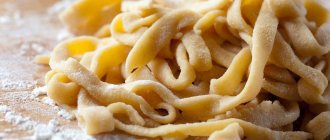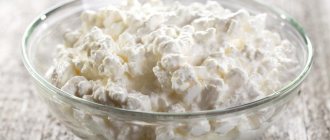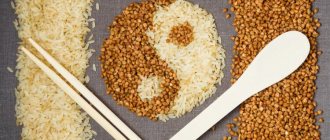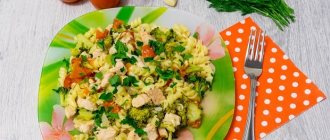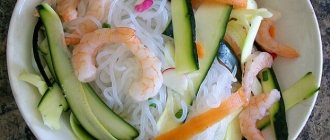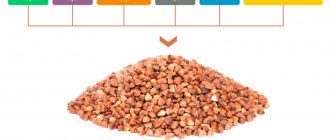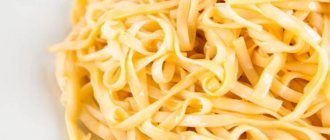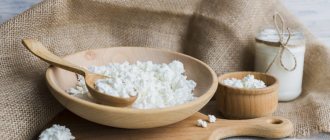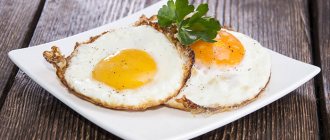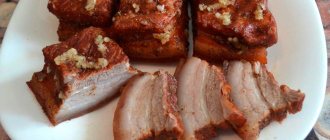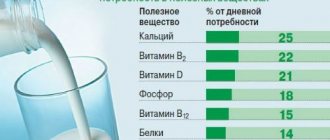People who have been on diets for a long time and are overweight dream of always eating to their fill, but not gaining weight.
Is something like this possible? The Japanese claim that there is nothing special about this way of eating and have been using it for many centuries. In the Land of the Rising Sun, a common plant called konnyaku is used as food. In European style, it can be called “snake palm” or “devil’s tongue,” which was given to it due to the strange appearance of its flower. It can really scare an unprepared person. However, there is nothing dangerous or scary about this plant. Many dishes are prepared from it, including shirataki noodles, and we will tell you what it is and what it is eaten with in our article.
Let's talk about konnyaku
If French cognac can dull the fear of gaining weight, then amorphophallus tubers can dull the feeling of hunger.
In Russia, people interested in the topic of rapid weight loss learned about Japanese noodles from an authoritative person - the famous nutritionist Pierre Dukan. He spoke about this amazing plant at one of the spring conferences.
For residents of Asian countries, konjac (konjac, cognac) is considered a traditional product, used not only in cooking, but also in everyday life. Thanks to the porous structure of the roots, sponges are made from the plant, which are famous for their phenomenal property of thoroughly cleansing the face.
In the kitchen, konnyaku has completely different functions: it is used as a gelling agent to thicken dishes and desserts, and the famous Shirataki pasta is made from konjac flour. The noodles perfectly absorb the aroma of the sauce, in addition allowing you to forget about the feeling of hunger for a long time - and all this without harm to the body and figure.
How to lose weight with noodles
If we are talking about ordinary noodles, then no way. But if you replace the traditional product with super-dietary Japanese noodles, then it’s very possible. Some people on the noodle diet won’t even have to radically revise their diet. In order to start the weight loss process, it is enough to replace regular pasta or potatoes with shirataki.
The most famous weight loss program in which shirataki is held in high esteem is the Dukan diet. For people who follow it, shirataki can be consumed in unlimited quantities. By the way, in Japan, more than 200 tons of this “pasta” are eaten annually and, it must be recalled, you rarely see overweight people in this country.
As already mentioned, Japanese noodles contain almost no calories, carbohydrates, fat, sugar, protein or gluten. And those carbohydrates that are in the product are digested very slowly in the small intestine. But the most important thing for those losing weight is that shirataki contains a special type of fiber known as glucomannan. When this substance combines with water, it swells very strongly, increasing to almost 17 times its original volume. In the human body, everything happens approximately the same way, and after eating Japanese noodles, a gel-like mass is formed in the stomach, which maintains saturation for a very long time. In addition, dietary fiber slows down the body's production of ghrelin, also known as the hunger hormone. And by comparing these data, it becomes clear: you can really lose weight very effectively using Japanese “pasta.”
Dukan recommends
The French nutritionist said that he learned about the benefits of the product quite by accident. At first, he studied the properties of the root vegetable for a long time and admired the fact that it contained large quantities of hydrocolloidal polysaccharide, that is, the rubbery glucomannan.
The chemical name, which is incomprehensible to the average person, can be explained as follows: glucomannan is essentially a carbohydrate and has a molecular structure. The substance is broken down extremely slowly by our body, and its molecules tend to retain and absorb moisture.
It’s not for nothing that glucomannan is nicknamed “the broom for the human body.” The sugars that make up the substance, entering the stomach, are released, and the absorption process takes place at an extremely slow rate.
Nutritional value and chemical composition
In Asian countries, shirataki is one of the national dishes and is almost as popular as rice. If someone tried to find another name for Japanese noodles, more familiar to the European ear, then it would probably not be better to find a literal translation of the original name. “White waterfall” is exactly how the Japanese word “shirataki” is translated. The product really looks like the cascading waves of a waterfall. White, translucent thin pasta, almost tasteless, but have a characteristic smell. This is explained by the fact that shirataki contains only two components: konnyaku root and water. Some manufacturers also add salt. The resulting mixture is boiled and then poured into noodle or rice molds.
Shirataki contains a lot of water - almost 97% of the total composition, and only 3% fiber.
These are the lowest calorie noodles in the world. It seems that only water contains fewer calories. 100 g of noodles contain only 9 kcal. This is almost 12 times less than in a green apple, and we dare to remind you that it is considered very low-calorie. But in fairness, it must be said that Japanese noodles lack not only calories. It also does not contain vitamins, minerals, fats, proteins (well, unless you add them during the cooking process), but there is a huge amount of fiber and some carbohydrates. But don't be afraid. Shirataki contains only 2.3 g of carbohydrates per 100 g of product, which will not affect your figure at all.
Separately, it is necessary to say about the characteristics of fiber obtained from snake palm. It is an insoluble substance that, when it enters the intestines, swells, creating a feeling of fullness in the stomach. But besides this, while konjac fiber remains in the human body, it absorbs toxins, excess cholesterol and glucose, and is then completely eliminated.
Beneficial features
From a medical point of view, Shirataki pasta has a number of advantages. The product is used to reduce weight and cholesterol levels, to control the body's condition in diabetes mellitus, as well as for the prevention of gastrointestinal treatment.
Its effectiveness in losing weight is explained by its ability to cleanse the body and delay the movement of incoming food through the digestive tract.
The noodles contain cognac mannan, which promotes the absorption of cholesterol. Thus, the presence of a high concentration of plant polysaccharide will make following a diet beneficial for the heart.
Shirataki noodles lower cholesterol levels
Several studies also show that glucomannan may help lower cholesterol levels.
We offer you: Japanese diet: benefits, food list and meal plan
Researchers note that glucomannan increases the amount of cholesterol excreted in stool, so less is reabsorbed into the bloodstream.
A review of 14 studies found that glucomannan reduced bad LDL cholesterol by an average of 16 mg/dL and triglycerides by an average of 11 mg/dL.
Summary: Research shows that glucomannan may help lower levels of “bad” LDL cholesterol and triglycerides.
Shirataki pasta: product composition
The production of various pasta products from konjac flour is growing by leaps and bounds. Among all varieties, spaghetti has gained popularity and fame. For its delicate consistency, the product received the beautiful poetic name “angel hair”. However, specifically for those losing weight, the following were developed: Shirataki vermicelli, fettuccine, layers for preparing lasagna, tagliatelle, cereals and rice.
The nutritional value of all the listed products is the same, and for people on a diet it is considered a cherished dream. Judge for yourself: the product is gluten and lactose free, the number of calories ranges from 0 to 9, fat - up to 0.3 g, and protein - up to 0.5. As for carbohydrates, they are still available. For example, in a standard portion of the finished product weighing 90 g, the carbohydrate content will be from 0.3 to 1 g. The glycemic index of noodles is 0.
Unfortunately, Shirataki pasta is practically sterile not only in terms of macronutrient content, but also in its vitamin and mineral composition. The only exception will be the iron content. According to experts, a standard serving of pasta contains about 8% of a person’s daily requirement.
But certain questions were raised by another product included in the pasta - calcium hydroxide, that is, slaked lime. Despite the fact that the additive is often used in cooking, experts warn that consuming E526 in large quantities will lead to a deterioration in health and also disrupt the functioning of the gastrointestinal tract.
What is funchose
As a rule, manufacturers indicate on the packaging what glass noodles are made of. Many claim that funchose vermicelli is made from rice. This is not entirely true. Glass noodles are made from mung bean starch, which is why they become transparent when cooked. Outwardly, it looks more like spaghetti rather than noodles.
Glass noodles are similar in appearance to rice noodles. Both varieties are made in the form of thin long threads. The difference between rice noodles and funchose becomes clear when cooked. The funchoza remains transparent, and the rice noodles turn white or pale yellow, like pasta.
Sometimes manufacturers offer other types of vermicelli. To prepare soups from shark fins or seafood, triangular-shaped funchose, reminiscent of fish fins, is used.
Another type of glass noodle is called shirataki, which is made from konjac and lime water, the latter giving the product its shape. The finished product may be in the form of noodles or rice. Shirataki is the lowest calorie product because it contains only 3% plant fiber.
Vermicelli is not used as a separate product, as it has no taste or smell. When cooking, it is seasoned with a large amount of aromatic spices and seasonings, which allows it to be given a unique, special piquant taste.
General cooking principles
The love of Americans and Europeans for the Asian product is due to the fact that it resembles pasta. However, don't expect the usual pasta taste from it. In terms of organoleptic qualities, Shirataki noodles resemble the well-known funchose.
Vermicelli behaves best in cold vegetable salads and in Asian dishes cooked in Chinese frying pans (woks). The neutral flavor turns the product into a blank canvas. Therefore, “Shirataki” can be combined with any sauce and additives. However, in this case, people on a diet need to be careful: if pasta made from konjac flour has almost zero calorie content, then the composition of an incorrectly selected sauce can nullify all the efforts of a losing weight person.
Shirataki noodles are sold in health food stores and are most often sold with the addition of soy. In this case, please note that, compared to the original, the konjac-soy product has a different calorie content and nutrient composition. Asian no-carb vermicelli should be stored in a cool place.
Shirataki noodles may lower blood sugar and insulin levels
Glucomannan has been shown to help lower blood sugar levels in people with diabetes and insulin resistance.
We bring you: 6 best supplements for gaining muscle mass
Because viscous fiber delays stomach emptying, blood sugar and insulin levels rise more gradually as nutrients are absorbed into the bloodstream.
In one study, people with type 2 diabetes who took glucomannan for three weeks experienced a significant reduction in fructosamine, which is a marker of blood sugar levels.
In another study, people with type 2 diabetes who took a single dose of glucomannan before drinking glucose had significantly lower blood sugar levels two hours later than after taking a placebo.
Summary: Shirataki noodles may slow stomach emptying, which may help prevent post-meal blood sugar spikes.
Shirataki pasta: salad recipes
With shrimps
Required recipe components:
- apple - 0.5 pcs.;
- carrots - 0.5 pcs.;
- garlic clove;
- honey - 2 tbsp. l.;
- vinegar - 1 tbsp. l.;
- a pinch of salt;
- olive oil - 100 ml + 50 ml for frying;
- lime - 3 pcs. (only juice is required);
- peeled shrimp - 14 pcs.;
- Shirataki pasta;
- arugula - 80 g;
- red chili pepper - 2 pcs.;
- cucumber;
- tomatoes - 2 pcs.;
- red bell pepper - 1/4 pcs.
Step-by-step technological process:
- Cut the cucumber with red pepper into thin slices and place in cold water.
- Peel the shrimp, but leave the tails.
- Drain the spaghetti and rinse under running water.
- Boil the noodles for 3 minutes in lightly salted water, drain in a colander and cool slightly.
- Dressing: cut the carrots and garlic into small cubes. Pour in vinegar and honey.
- Then add finely chopped apple and lime juice to the dressing.
- Salt and pour in 100 ml of oil.
- Fry the shrimp with garlic until they turn pink;
- In a salad bowl, mix arugula, chopped tomato and red pepper with cucumbers.
- Add spaghetti and fried shrimp.
- Pour in all the dressing, stir and serve.
With tuna
Required recipe components:
- Shirataki packaging;
- tuna - 100 g;
- chopped greens to taste;
- sesame - 10 g;
- soy sauce to taste;
- spices.
Step-by-step technological process:
- Boil water and cook spaghetti in liquid for 2 minutes. When ready, drain in a colander.
- Cut the fish fillet into pieces no larger than 3 cm, add salt and fry.
- As soon as the tuna is covered with a crust, remove the product from the heat.
- Mix fish with spaghetti, season with sauce, sprinkle with sesame seeds and herbs.
Use in cooking
The product is widely used as an additional ingredient. Since it has no taste or smell, it is not served as an independent dish.
It is most often used for preparing salads, soups or complex side dishes.
Very often, bean noodles are called rice noodles, since they are very similar in appearance, but bean noodles are more tender and go better with hot sauces, smoked chicken, pork, beef, fresh carrots and cucumbers.
In Japanese and Chinese cuisine, vermicelli is served with sweet and sour or hot sauce, which contains a large amount of spices and herbs that stimulate the appetite.
How to choose the right one
To prepare dishes, only high quality Chinese noodles are required
To prevent disappointment in the kitchen, you should pay attention to several points when purchasing a product:
- you need to carefully study the composition;
- the noodles should be transparent white or light gray; a yellow tint indicates that the product has been on the store shelf for a long time;
- the threads should not stick together, they should be at least 50 centimeters long and up to 3 mm wide;
- the product, regardless of the thickness of the threads, is fragile;
Cooking rules
Funchoza is very easy to prepare. It complements the taste of meat, fish and vegetables well, since it itself has a neutral taste.
Chinese noodles should be boiled until transparent. To do this, you should take the advice of professionals:
- bring water to a boil;
- Place the funchose into boiling water, carefully so as not to break the threads, and cook for two minutes;
- Place the finished product in a colander and let the water drain.
- Rinse with cold water so that the finished vermicelli retains its shape. Boiled noodles are used as a base for preparing a variety of dishes.
Vermicelli can be steamed using a special tray in a multicooker or steamer. You can add pieces of meat, chicken, fish, vegetables or seafood to the finished base in combination with seasonings and sauces.
Very often on store shelves you can see glass noodles tied into “nests”. This type of noodles is prepared according to general rules. Only after it is welded, it is necessary to cut the threads. “Nests” are the most convenient form for cooking, since in case of overcooking they practically do not stick together.
It is not recommended to store funchose in broth for a long time, as it quickly loses its attractive appearance and taste.
Chinese noodle dressing recipe
Since funchose has a neutral taste and no odor, it should be eaten seasoned with spices or sauce. You can buy ready-made dressing in the store, but the most delicious noodle sauce is the one you make yourself.
For it you will need ground coriander and red hot pepper, taken in equal parts, one teaspoon of sesame oil and a little soy sauce. The spices are thoroughly mixed, oil and soy sauce are added to them. After this, the dressing is placed in a cold place. Additionally, you can add other seasonings that will give the dishes a piquant taste. This sauce goes well with meat and vegetables. What spices to use depends on the housewife.
Vegetable lunch
Required recipe components:
- spaghetti packaging;
- sweet pepper - 1 pc.;
- hot pepper - 1 pc.;
- green onion feathers - 2 pcs.;
- tomato - 1 pc.;
- olive oil - 15 ml;
- ground paprika and other spices to taste.
Step-by-step technological process:
- Open the package of spaghetti, drain the brine, and boil the product itself in slightly salted boiling liquid for 3 minutes. When ready, drain in a colander.
- Finely chop 2 types of pepper and fry, after sprinkling with paprika and other spices.
- Add greens, diced tomatoes and spaghetti that have cooled by this time to the hot peppers.
Advice! Spicy food enhances the metabolic process, but for stable stomach function, the dish prepared according to the proposed recipe should not be consumed too often. If you like a vegetable lunch, you can cook it without hot pepper.
Product advantages
Funchoza for weight loss
This type of noodles has a completely positive effect on the human body due to the huge number of vitamins and beneficial components it contains. Asians call funchose an ideal product. It contains fiber, which improves digestion processes, removes harmful substances and toxins from the body, and with frequent consumption has a positive effect on the functioning of the heart and helps make blood vessels elastic. Glass noodles are an excellent remedy against depression; they rejuvenate body cells, improve brain function, and the condition of hair and nails. Funchose contains almost no protein and no gluten at all, so this dish is suitable even for those who are highly prone to allergies.
Shirataki with turkey
Required recipe components:
- spaghetti packaging;
- turkey - 300 g;
- bell pepper;
- shallots - 2 pcs.;
- green onions - 2 bunches;
- broccoli - a small head;
- garlic clove;
- ginger - 10 g.
Ingredients for the sauce:
- coconut milk - 200 ml;
- peanut butter - 4 tbsp. l.;
- juice of half a lemon (can be replaced with lime);
- brown sugar - 2 tbsp. l.;
- soy sauce - 2 tbsp. l.;
- You can add chili sauce if you wish.
Step-by-step technological process:
- Rub the turkey with salt and spices and fry until the meat turns white.
- Next, fry the grated ginger, shallots and chopped garlic in the same oil.
- When the vegetables are soft, add the turkey to the pan and stir.
- Boil spaghetti according to package instructions.
- Mix the ingredients for the sauce in a separate bowl and bring to a boil.
- Combine sauce with turkey meat and spaghetti.
- Sprinkle the finished dish with green onions.
Calorie table for all salads
So that you don’t have to think about whether and in what quantity you can eat this or that salad while on a diet, refer to this table.
| salad | calorie content, kcal |
| With vegetables | 461 |
| With vegetables and chicken | 766 |
| With vegetables and shrimp | 690 |
| With vegetables and mushrooms | 695 |
| With vegetables and asparagus | 553 |
| With vegetables and pork | 1500 |
| With vegetables “Korean style” | 712 |
| With vegetables and rapana | 691 |
Remember that the daily calorie intake depends on lifestyle and age. For women:
- from 19 to 25 years: 2-2.4 thousand kcal;
- up to 50 years: 1.8-2.2 thousand kcal;
- over 50 years old: 1.6-2 thousand kcal.
For men, the norm is 200-500 kcal higher. If you are on a diet, keep in mind that these numbers need to be reduced by 100-200 kcal.
Funchoza is not a familiar product to us yet. But don't be afraid to experiment! These noodles themselves are almost tasteless, so they are imbued with the aromas and flavors of other ingredients in the prepared dishes. It is unlikely that you will be able to make a mistake and make it tasteless, so when you see a package of funchose in the store, feel free to take it! You will definitely find something to cook with it.
Pumpkin puree soup with Shirataki spaghetti
Recipe ingredients required:
- tofu - 100 g;
- Shirataki packaging;
- pumpkin - 0.5 kg;
- bell pepper - 1 pc.;
- cream 9% fat - as much as needed in the process.
Step-by-step technological process:
- Drain the brine from the spaghetti and place the product in a colander;
- Cut the peeled pumpkin into slices, add liquid and simmer until soft;
- Mash in a blender and pour in a small amount of cream;
- Grind the pepper, cut the tofu into slices and add to the pumpkin;
- Bring the mixture to a boil, add spaghetti and finish cooking after 4 minutes.
What funchose (glass noodles) are made from, composition and calorie content
Boiled funchoza
Funchoza is one of the traditional dishes in Asia, it is also called glass noodles. As you know, Asia is one of the suppliers of exotic dishes, one of which is funchose. What is funchose made from? What is its composition? And what are the benefits and harms of noodles for our body?
What are glass noodles made from?
Dry funchose is similar to rice noodles, but after cooking it takes on a translucent appearance, hence the name glass noodles. Glass noodles are obtained from mung bean starch (also known as Mung).
Dry funchose
In Russia, glass noodles are mistakenly called rice noodles, but rice noodles, which are made from rice flour, become white after cooking and are no different in appearance from spaghetti, while funchose becomes translucent after cooking.
Composition of funchose
A completely natural product per 100 grams has the following composition:
- 84g carbohydrates,
- 0.7g protein,
- 0.5 g fat.
Also, bean noodles (another name for funchozu) include vitamins B1, B2, B5, B6, B9, PP, as well as sodium, phosphorus, potassium, calcium, magnesium, zinc, iron, manganese, selenium, copper.
The calorie content of funchose is approximately 320 kcal per 100 grams of product.
Funchoza - benefits and harm
Like all products containing a large amount of vitamins, micro and macroelements in their composition, funchose has a beneficial effect on the human body. Thus, B vitamins have a positive effect on the nervous system, and vitamin PP has a positive effect on the circulatory system.
Due to the small amount of fat, some nutritionists recommend consuming funchose during diets.
The main harm when eating glass noodles may be due to other components of the dish using them, for example, sauces. Various sauces may have adverse effects on the stomach, pancreas or liver.
People's opinion
What do consumers think about Asian Shirataki pasta? Reviews from customers and those losing weight agreed that carbohydrate-free spaghetti is an ideal option for a diet. The only drawback of the product was the weight. Consumers noted that the portion is only enough for one person.
Other buyers noticed the taste. In their opinion, it is indistinguishable from rice noodles, only if you eat Shirataki before bed, you will not be so ashamed of yourself and your own cowardice. After all, it is low-calorie, which means you shouldn’t expect damage to your figure from it.
Harm and side effects of Japanese noodles
After reading the eulogies, many people think that this vermicelli brings one benefit. However, it happens that it can cause not entirely pleasant side effects. So what to fear and what to count on?
- For many people who are not accustomed to such exotic products, shirataki causes bloating, diarrhea, and indigestion.
- For people suffering from anorexia, eating these foods may not be suitable. It can do harm instead of good.
- The substance glucomannan, which helps remove toxins, can also prevent some medications from being properly absorbed and absorbed by the body.
Therefore, those who take medications should be extremely careful and cautious. But you shouldn’t give up shirataki completely. You can take tablets or mixtures an hour or two before meals or four hours after. Then the negative effect will be reduced to zero.
Shirataki helps with constipation
Chronic constipation is a very common problem. This is often associated with obesity and other diseases described above. With shirataki noodles, you can solve all your problems at once.
A number of studies have shown that glucomannans are good for relieving constipation in both children and adults. In studies with adults, glucomannans have been found to promote intestinal motility, increase beneficial gut bacteria, and accelerate the production of short-chain fatty acids. All these three properties provide relief from constipation.
